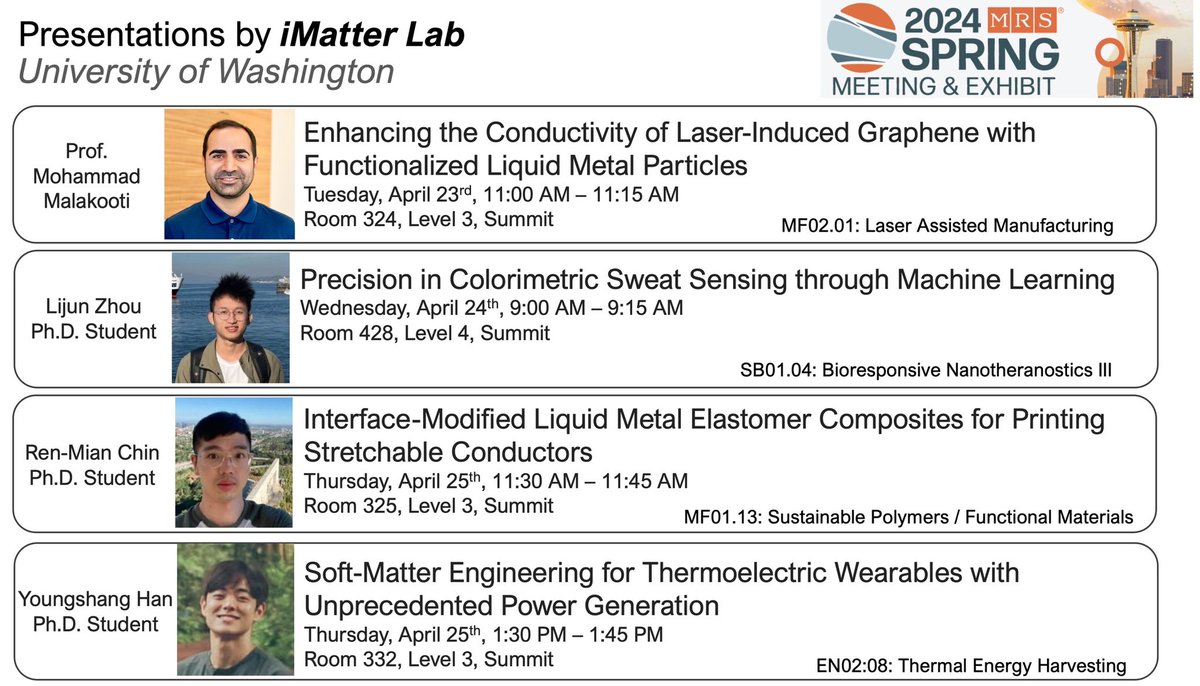
Mohammad Malakooti
@momalakooti
Assistant Professor, Mechanical Engineering Department, University of Washington @UW - Previously @UF, @UMich, @CMUEngineering
ID: 1015395961240276992
https://sites.google.com/view/malakooti 07-07-2018 00:43:57
89 Tweet
237 Followers
256 Following

What better way to power wearable electronics than by harvesting the energy in body heat? This stretchable thermoelectric generator is designed to do just that Mohammad Malakooti Mechanical Engineering at UW iMatter Lab 👉 ow.ly/bve850Kbjwn


UW researchers, led by ME Assistant Professor Mohammad Malakooti, have developed a wearable, stretchable thermoelectric device that converts body heat to electricity. Learn more about the research, published recently in Advanced Energy Materials: me.washington.edu/news/article/2… iMatter Lab


UW researchers, led by Mechanical Engineering at UW Assistant Professor Mohammad Malakooti, have developed a wearable, stretchable thermoelectric device that converts body heat to electricity. ⚡ Read more: ms.spr.ly/6017jdV1t #UWinnovates


A team led by Mechanical Engineering at UW prof Mohammad Malakooti, has developed a wearable thermoelectric device that converts body heat to electricity, which can provide continuous power to wearable electronics like health & fitness trackers or virtual reality headsets. nano.uw.edu/harvesting-the…



Congratulations to the 2023 Northwest Nanotechnology Seed Grant awardees: UW ECE's Brant Bowers and Serena Elay and Mechanical Engineering at UW's Mohammad Malakooti! nano.uw.edu/nanoes-announc…


Assistant Professor Mohammad Malakooti & Assistant Professor Krithika Manohar recently received an U.S. National Science Foundation grant to establish a design framework for soft multifunctional #composites and investigate their failure under large deformations. me.washington.edu/news/article/2… iMatter Lab


Mechanical Engineering at UW, UW Bioengineering, and UW Medicine researchers developed a new leadless pacemaker that harnesses the energy from heartbeats to partially recharge its battery, addressing challenges in traditional pacemakers. Learn more in an article from American Heart Association newsroom.heart.org/news/experimen…

Heartbeats could one day help power something beyond hearts. Researchers, co-led by ME Assistant Professor Mohammad Malakooti, are creating a device that harvests heartbeat energy to extend battery life in leadless pacemakers. me.washington.edu/news/article/2… iMatter Lab UW Bioengineering UW Medicine


BioLegacy, ShockSafe and Piezo-Pulse are student teams with ME students and/or faculty advisers that received awards at the UW Buerk Center Hollomon Health Innovation Challenge. Congratulations to all! blog.foster.uw.edu/2024-hollomon-…

ICYMI! Green synthesis of iron-doped graphene quantum dots: an efficient nanozyme for glucose sensing by Mohammad Malakooti, Miqin Zhang and colleagues University of Washington Mechanical Engineering at UW Materials Science & Engineering at UW is out now in Nanoscale Horizons 👇 pubs.rsc.org/en/Content/Art…

Four presentations from our research team iMatter Lab at #S24MRS ! Looking forward to it!







The UW Daily wrote a great write-up on Mechanical Engineering at UW and NanoES professor Mohammed Malakooti's wearable device, which lights up an LED using only the warmth of your skin. dailyuw.com/science/uw-ins…


Wearable technology just got a power boost! University of Washington researchers have developed a thermoelectric device that can turn your body heat into a power source for smartwatches and other gadgets: asme.org/topics-resourc…

